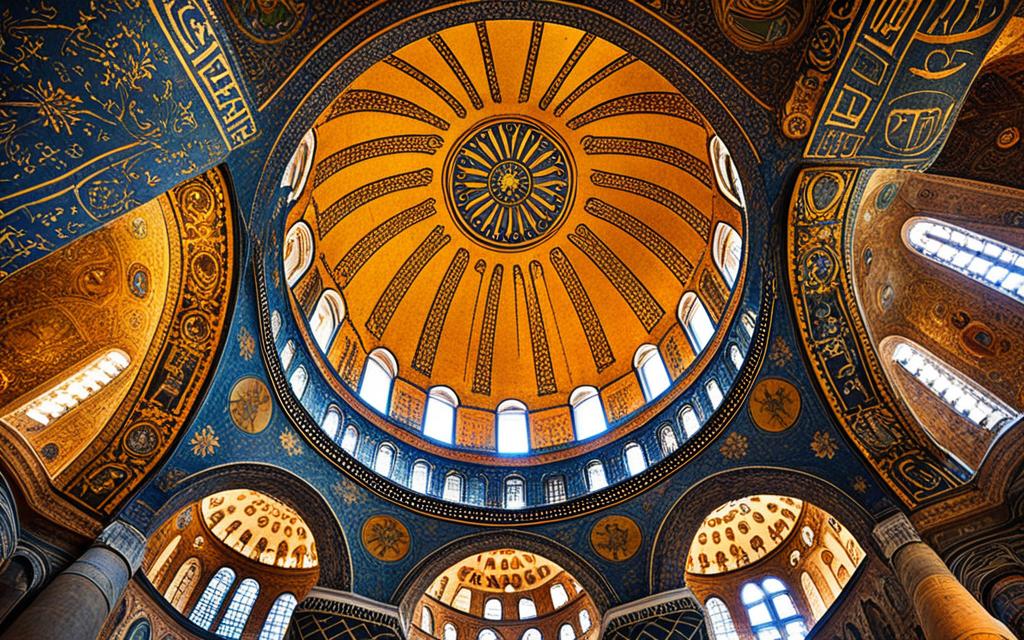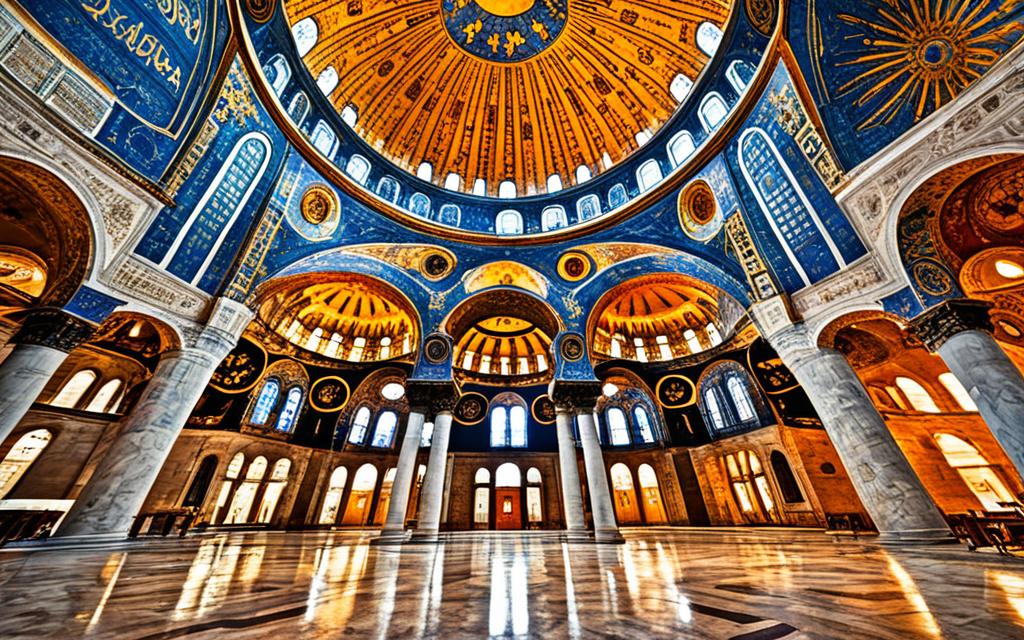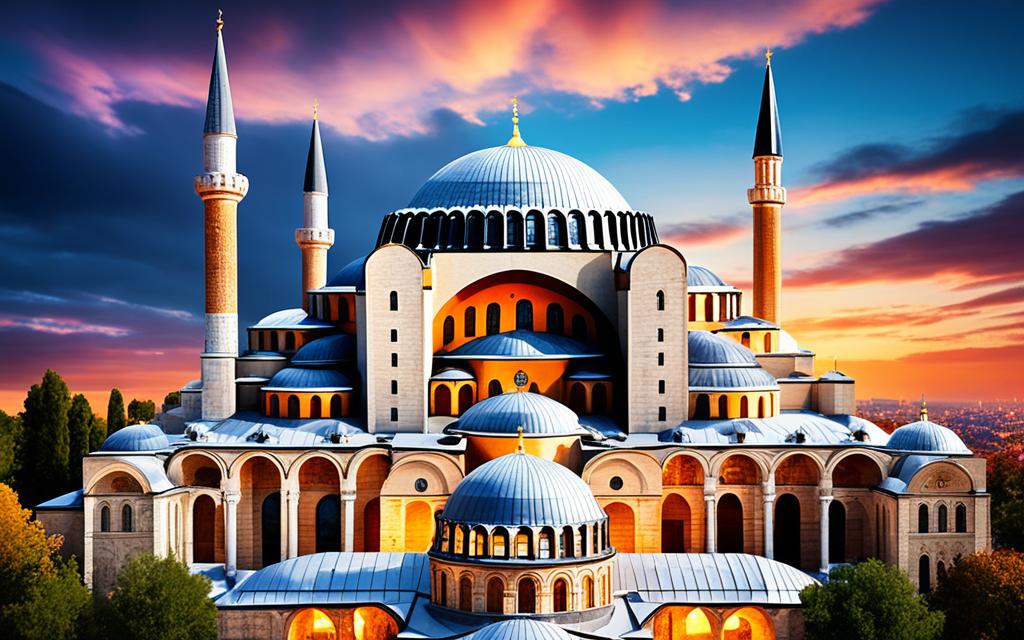Walk into the Hagia Sophia through its grand archways and feel its greatness. This iconic structure has a scale and grandeur that are awe-inspiring. You’ll hear the whispers of history in the air, leading you to uncover the rich cultures tied to this architectural gem. Regardless of your interest, the Hagia Sophia will charm and uplift you.
Emperor Justinian the Great ordered the building of the Hagia Sophia in the 6th century. It showcases the brilliance of the Byzantine Empire in Istanbul, Turkey. Originally a Christian basilica, this masterpiece features the best of Byzantine architecture.
Key Takeaways
- The Hagia Sophia is a magnificent architectural masterpiece that blends Christian and Islamic influences, reflecting the cultural fusion of ancient civilizations.
- Commissioned by Emperor Justinian the Great in the 6th century, the Hagia Sophia was originally constructed as a Christian basilica and served as the centerpiece of the Byzantine Empire’s religious and cultural life.
- The Hagia Sophia’s innovative dome design, exquisite mosaics, and harmonious integration of architectural elements have inspired countless other religious structures throughout the Byzantine era and beyond.
- The Hagia Sophia holds immense symbolic significance as an embodiment of cultural fusion and a testament to religious tolerance, serving as a site of worship for both Christians and Muslims.
- Preserving the Hagia Sophia’s architectural and cultural legacy has been an ongoing challenge, requiring meticulous maintenance and restoration efforts to address the impacts of time and environmental factors.
The Hagia Sophia: An Introduction
The Hagia Sophia, called Ayasofya in Turkish, is a stunning work of architecture. It was built under the Emperor Justinian the Great in the 6th century. At first, it was a Christian basilica that showed off the Byzantine architecture of the time.
Architectural Marvel of Byzantine Era
The design and build of the Hagia Sophia amazed many. It boasts a large dome and a complex system of arches. These features have made it a standout example of Byzantine Empire architecture wonders.
Blending Christian and Islamic Influences
Many changes have happened to the Hagia Sophia over time. From being a Christian site, later, it was turned into an Ottoman mosque. This change added Islamic art to its look.
Now, it shows how different cultures and beliefs can come together in one place. It’s a symbol of how religious sites can change and stay important over the years.
The Hagia Sophia’s Rich History
The Hagia Sophia‘s story shows the change of religious and political power in its area. It was started as a Christian basilica in the 6th century by Emperor Justinian the Great. For almost a thousand years, this grand structure shined as the heart of the Byzantine Empire‘s faith and culture.
Origins as a Christian Basilica
This amazing building was designed by Anthemius of Tralles and Isidore of Miletus. The Hagia Sophia’s unique domes soon became a worldwide symbol of the Byzantine Empire‘s might and faith. It attracted people from all over.
Transition to an Ottoman Mosque
In 1453, things changed when the Ottomans took Constantinople. Sultan Mehmet II turned the Hagia Sophia into a mosque. This marked the start of a new chapter filled with Islamic art and architectural changes.
Becoming a Museum and UNESCO World Heritage Site
After the Ottomans fell, the Hagia Sophia changed again. In 1934, it became a museum thanks to Mustafa Kemal Atatürk, the founder of modern Turkey. By 1985, everyone knew it was special when it was declared a UNESCO World Heritage Site.

Architectural Grandeur of the Hagia Sophia
The Hagia Sophia is a marvel of Byzantine architecture. It showcases the incredible skill of its designers. The center is home to a huge dome. It measures 105 feet across and rises 180 feet high. This, along with many arches and semi-domes, was a feat back in the 6th century. It’s still an epic example of architectural wonders.
Innovative Dome and Structural Design
The central dome at the Hagia Sophia is a wonder. It shows off what Byzantine architects were capable of. With its special design, it opened up a large, free space inside. Such a design was totally new at that time. It not only looks amazing but also shows off the building’s solid structure. Truly, the Hagia Sophia shines as an architectural wonder.
Exquisite Mosaics and Interior Decor
Inside the Hagia Sophia is a celebration for the eyes. It’s filled with exquisite mosaics and detailed decorations. These are the best examples of Byzantine art and architecture. The mosaics show religious scenes, figures, and patterns. They turn the place into an immersive experience for everyone. This proves the incredible talent of the Byzantine craftsmen. They made the Hagia Sophia not just a place of worship but a piece of art in Islamic art and architecture.
The Hagia Sophia’s Influence on Byzantine Architecture
The Hagia Sophia greatly impacted Byzantine architecture and religious buildings of its time. With its huge size and unique dome, it blended Christian and Islamic features. This mix inspired the construction of many similar structures across the Byzantine Empire and other areas.
Inspiration for Religious Monuments
The church’s design influenced many religious buildings in the Byzantine Empire. Its use of domes, arches, and semi-domes was pioneering. Inside, detailed mosaics and decorations were admired and copied in churches, cathedrals, and mosques.
Enduring Legacy in Istanbul’s Skyline
Even today, the Hagia Sophia’s shape stands out in the Istanbul skyline. It represents the lasting impact of Byzantine architecture and the region’s culture. As one of Istanbul‘s most known landmarks, it welcomes visitors from across the globe.

The Hagia Sophia’s Symbolic Significance
Besides its stunning architecture, the Hagia Sophia carries deep meaning. It shows how cultures came together, celebrating their differences. As a place of worship for Christians and Muslims, it honors the region’s varied heritage and faiths. This makes it more than just a building; it’s a symbol of unity in diversity.
Embodiment of Cultural Fusion
The Hagia Sophia is a breathtaking mix of Christian and Islamic design. It represents the beauty found when different worlds meet. The blend in its architecture speaks to the rich cultural background of its home. And it stands as proof that communities of various beliefs can live together and flourish.
Icon of Religious Tolerance
Being used by Christians and Muslims for worship makes the Hagia Sophia special. It highlights a long history of religious tolerance in the area. As such, this iconic landmark promotes a message of peace and cooperation between religions. It encourages all who visit to appreciate the benefits of a world that welcomes everyone.
Preservation Efforts and Ongoing Restoration
Keeping the Hagia Sophia in good shape is tough work. It’s a UNESCO World Heritage Site. This means it’s important to look after it carefully. It has faced many years of use and the damage of time, weather, and people. So, it always needs maintenance and repairs to stay strong.
Challenges in Maintaining the Hagia Sophia
The Hagia Sophia faces many challenges. It deals with its own weight, the weather, and what centuries of people have done. Balancing modern needs with its historic value is very hard. Those taking care of it work hard to find solutions.
Initiatives for Sustainable Conservation
To keep the Hagia Sophia safe for the future, new efforts are being made. These include smarter ways to fix it, controlling the building’s environment, and teaching others how to help. They want everyone to understand why this UNESCO World Heritage Site is so special.
People continue to invest in the Hagia Sophia‘s future. By doing this, they hope to save it as a special place for people to enjoy. This way, its beauty and history can be shared with many more generations.
Conclusion
The Hagia Sophia is all about human ability and the Byzantine Empire’s amazing culture. This stunning building shows off its big dome, beautiful mosaics, and a mix of Christian and Islamic styles. People from all over the world have fallen in love with it for years. It’s not just a place, it’s a World Heritage Site that tells Istanbul’s colorful past through its architecture.
This place is more than just its looks. It tells a story of bringing different cultures and religions together. Over time, it turned from a Christian basilica to an Ottoman mosque and now it’s a museum. This shows how it has easily changed with the world, becoming a symbol for all.
Keeping the Hagia Sophia’s beauty alive is a big task. It needs careful fixing and looking after. But it’s worth it because this place reminds us of what we can create together and how important it is to protect our past for the future.




